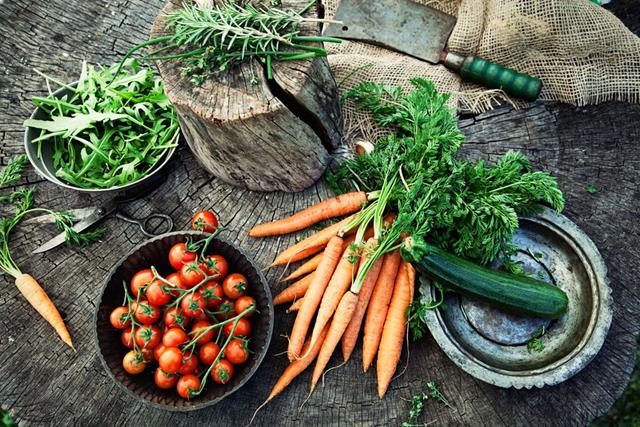Looking to create a thriving vegetable garden in a partially shaded area? Choosing the right plants for partial shade vegetable gardens is crucial for success. Partial shade, defined as an area that receives 3-6 hours of sunlight per day, presents unique challenges and opportunities for growing vegetables. It’s important to understand how partial shade conditions affect plant growth and to select varieties that are well-suited for these environments.
When planning a partial shade vegetable garden, it’s essential to choose plants that thrive in these conditions. This ensures that your garden will yield a bountiful harvest despite receiving less sunlight than traditional full-sun gardens. In this article, we’ll explore the best vegetables for partial shade gardens, provide tips for designing and preparing the garden, and offer advice on caring for and maintaining your vegetable plants in partially shaded areas.
By selecting the right plants and following best practices for gardening in partial shade, you can create a beautiful and productive vegetable garden that thrives in less-than-ideal sunlight conditions. With proper planning and care, your partially shaded garden can yield a plentiful harvest of delicious, homegrown vegetables.
Best Vegetables for Partial Shade Gardens
When planning a vegetable garden in an area with partial shade, it is crucial to select plant varieties that can thrive in these conditions. While some vegetables require full sun for optimal growth, there are plenty of options that can still produce a bountiful harvest with limited sunlight. Here are some of the best vegetables for partial shade gardens:
- Leafy Greens: Spinach, kale, and lettuce are excellent choices for partially shaded areas. These vegetables prefer cooler temperatures and can tolerate less sunlight compared to other crops.
- Root Vegetables: Plants such as beets, carrots, and radishes can also thrive in partial shade. They benefit from some protection from the hot afternoon sun and will still develop delicious roots in these conditions.
- Herbs: Many herbs, including mint, parsley, and cilantro, can do well in areas with partial shade. These aromatic plants often appreciate some relief from intense sunlight and can be a great addition to your shaded vegetable garden.
It’s important to note that while these vegetables are more tolerant of partial shade, they still require some direct sunlight each day to produce a successful harvest. When choosing which varieties to grow in your partially shaded garden, consider the specific requirements of each plant and ensure that they will receive enough light to thrive.
By selecting the right vegetables for your partial shade garden, you can enjoy a diverse range of produce without the need for full sun exposure. Whether you’re growing leafy greens for salads or root vegetables for hearty stews, there are plenty of options available for your shaded growing space. With proper care and attention to their specific needs, these plants can provide a rewarding harvest despite the limitations of partial shade conditions.
Planning and Designing Your Partial Shade Garden
When planning and designing your partial shade garden, it’s important to consider the specific needs of the vegetable plants you intend to grow. Some vegetables thrive in partial shade and can actually benefit from the relief from the hot sun. When choosing plants for partial shade vegetable gardens, it’s essential to select varieties that are suited to these conditions.
Leafy greens such as spinach, lettuce, and kale are excellent choices for partially shaded areas. These vegetables require less direct sunlight and can even bolt or turn bitter if exposed to too much heat.
In addition to selecting the right vegetables, effective design and layout of your garden can help maximize the available sunlight. When planning your garden layout, take into account the shade patterns created by surrounding trees or buildings. By strategically placing your vegetable beds, you can ensure that each plant receives the appropriate amount of sunlight throughout the day. Consider using taller plants or trellises on the northern side of your garden beds to minimize shading effects on other plants.
Another important aspect of planning and designing a successful partial shade garden is understanding how different crops may interact with each other in terms of light requirements. For example, taller crops such as tomatoes or pole beans might cast shadows on smaller plants if not placed thoughtfully. It’s beneficial to create a companion planting scheme where taller sun-loving plants provide some shade for those that prefer less intense light.
| Vegetable | Light Requirements |
|---|---|
| Lettuce | Partial Shade |
| Spinach | Partial Shade |
| Kale | Partial Shade |
Soil Preparation for Partial Shade Vegetable Gardens
Guidelines for Preparing the Soil
When it comes to growing vegetables in partial shade, soil preparation is crucial for the success of your garden. Start by testing the soil to determine its pH levels and nutrient content.
Amending the soil with organic matter such as compost or well-rotted manure can help improve its structure and fertility, providing a better environment for plant growth. Additionally, consider adding a balanced fertilizer specifically formulated for vegetable gardens to ensure that your plants receive essential nutrients despite the limited sunlight.
Importance of Proper Drainage and Nutrients
In partial shade conditions, where sunlight may be limited, water drainage becomes even more critical. Be sure to improve soil drainage by incorporating organic matter into heavy clay soils. This will prevent waterlogging and root rot, which can become significant issues in shaded areas.
Furthermore, ensuring that the soil contains sufficient nutrients is essential for robust plant growth. Consider using slow-release fertilizers or liquid fertilizers applied at regular intervals to provide your vegetable plants with the necessary nutrients they need to thrive in partial shade.
Choosing the Right Plants for Your Soil Type
Different vegetables have varying soil requirements, so it’s important to select plants that are well-suited to your particular soil type. For example, leafy greens like spinach and lettuce tend to perform well in fertile, well-drained soils typical of partial shade environments.
Root vegetables such as carrots and radishes also prefer loose, well-draining soils. By taking into account your soil characteristics and matching them with suitable vegetable varieties, you can set yourself up for a successful harvest despite the challenges of partial shade gardening.
Care and Maintenance of Vegetables in Partial Shade
When it comes to maintaining a vegetable garden in partial shade, there are several key factors to consider to ensure the health and productivity of your plants. One of the most important aspects is watering. In partially shaded areas, the soil may not dry out as quickly as it would in full sun, so it’s essential to monitor the moisture levels regularly.
Watering should be done deeply but infrequently to encourage strong root growth. Using a soaker hose or drip irrigation system can help deliver water directly to the roots of the plants without wetting their foliage excessively.
In addition to proper watering, fertilizing is crucial for the success of vegetables in partial shade. Since these plants may not receive as much sunlight for photosynthesis, they often have limited energy reserves. Therefore, providing them with a balanced fertilizer rich in essential nutrients is essential for their growth and development. Organic options such as compost or fish emulsion can be beneficial for enriching the soil and promoting healthy plant growth without causing nutrient imbalances.
Another important aspect of caring for vegetables in partial shade is managing pests and diseases that thrive in these conditions. With reduced airflow and sunlight, partially shaded areas can create an environment conducive to certain pests such as slugs and snails, as well as fungal infections. Regularly inspecting the plants for signs of damage or disease, practicing crop rotation, and using natural pest control methods can help minimize these issues and keep your vegetable garden thriving.
| Aspect | Consideration |
|---|---|
| Watering | Monitor moisture levels regularly; use soaker hoses or drip irrigation systems |
| Fertilizing | Provide balanced fertilizer rich in essential nutrients; consider organic options like compost or fish emulsion |
| Pest & Disease Management | Inspect plants regularly; practice crop rotation; use natural pest control methods |
Container Gardening for Partial Shade
When it comes to growing vegetables in a partial shade setting, container gardening can be a practical and effective solution. Not only does container gardening allow for greater control over the amount of sunlight that your plants receive, but it also offers the flexibility to move the containers around to optimize sun exposure throughout the day. Here are some of the best vegetable plants to grow in containers in a partial shade environment:
- Lettuce: Lettuce is a versatile and popular choice for container gardening in partial shade. It thrives in cooler temperatures and can tolerate less sunlight than other vegetables. Choose varieties such as looseleaf or butterhead lettuce for best results.
- Spinach: Another leafy green that performs well in containers with partial shade is spinach. This nutrient-rich vegetable can handle lower light conditions and can be harvested continuously throughout the growing season.
- Radishes: For a quick-growing crop in partial shade, consider planting radishes in containers. These root vegetables do well with limited sunlight and are perfect for smaller, shallow containers.
In addition to choosing the right vegetables for your partial shade container garden, it’s essential to select the appropriate size and type of containers. Ensure that the containers have proper drainage holes to prevent waterlogging, and consider using lightweight, portable pots if you plan on moving them frequently to capture available sunlight.
Finally, regularly monitor soil moisture levels and water as needed, as containers may dry out more quickly than traditional garden beds. By following these tips and selecting suitable vegetable plants for your partially shaded container garden, you can enjoy a bountiful harvest of fresh produce right at your fingertips.
Companion Planting in Partial Shade Gardens
Understanding Companion Planting
Companion planting is a gardening technique where different plants are grown in close proximity to one another for mutual benefit. In partial shade gardens, companion planting becomes especially important as certain plants can help provide shade for others, improve soil conditions, or repel pests. Understanding which plants work well together in this setting can lead to healthier and more productive vegetable gardens.
Benefits of Companion Planting in Partial Shade
When it comes to partial shade gardens, companion planting offers several benefits. Some plants thrive in the dappled sunlight under the canopy of larger trees, while others can help enrich the soil with nutrients that may be leached away by tree roots. Additionally, certain plant combinations can deter pests and attract beneficial insects, creating a balanced ecosystem within the garden. By strategically pairing compatible plants, gardeners can make the most of the available sunlight and create a harmonious growing environment.
Recommended Companion Plant Combinations
For partial shade vegetable gardens, some popular companion plant combinations include planting leafy greens like lettuce and spinach alongside taller crops such as beans or tomatoes. Lettuce provides cover and shade for the delicate leaves of spinach while allowing enough light to filter through for both crops.
Likewise, interplanting aromatic herbs like basil or thyme with vegetables can confuse pests and mask the scent of vulnerable plants. By experimenting with different pairings and observing their effects on plant growth and overall garden health, gardeners can find successful companion plant combinations that work well in their specific partial shade conditions.
Success Stories and Tips From Experienced Partial Shade Gardeners
In conclusion, cultivating a thriving vegetable garden in partial shade is not only possible but can also yield bountiful harvests with the right planning and careful selection of plants. By understanding the unique requirements of vegetables for partial shade conditions and implementing effective design and care strategies, gardeners can create successful gardens even in less than ideal lighting situations.
Choosing the right plants for partial shade vegetable gardens is crucial to ensuring a successful harvest. With a variety of vegetables specifically suited for partial shade, such as leafy greens, root vegetables, and certain herbs, gardeners have plenty of options to work with. By selecting these plants and providing them with proper care and maintenance, it is entirely possible to enjoy a rich bounty of fresh produce from a partially shaded garden.
Furthermore, learning from experienced partial shade gardeners can offer valuable insight and practical tips for overcoming challenges in cultivating vegetables in less than optimal lighting conditions. Their success stories serve as inspiration for novice gardeners looking to venture into partial shade gardening.
By applying their advice and adapting it to their own garden spaces, aspiring gardeners can look forward to experiencing their own successes and reaping the rewards of their efforts. With careful planning and dedication, anyone can enjoy a thriving vegetable garden in partial shade.
Frequently Asked Questions
What Vegetable Plants Can Tolerate Partial Shade?
Some vegetable plants that can tolerate partial shade include leafy greens like spinach, lettuce, and kale. Root vegetables such as beets and carrots can also thrive in partial shade conditions.
What Vegetables Only Need 4 Hours of Sun?
Certain vegetables only require 4 hours of sun each day to grow successfully. These include crops like radishes, salad greens, and peas. These plants are well-suited for gardens with limited sunlight.
Can Tomatoes Grow in Partial Shade?
Tomatoes generally prefer full sun to produce the best yields and tastiest fruits. However, they can still grow in partial shade, albeit with reduced productivity. If growing tomatoes in partial shade, it’s important to select varieties specifically suited for these conditions.

If you’re looking to get into vegetable gardening, or are just looking for some tips on how to make your current garden better, then you’ve come to the right place! My name is Ethel and I have been gardening for years. In this blog, I’m going to share with you some of my best tips on how to create a successful vegetable garden.





